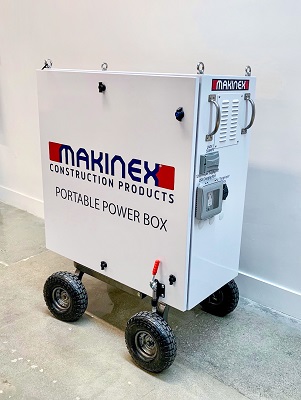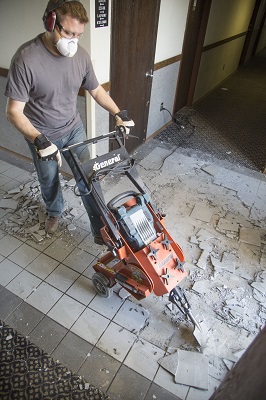While surface preparation is often seen as one aspect of a broader coatings application project, there can be numerous steps just within that one phase. Factors to consider may include safety protocols, power supply, climate control, pressure washing, chemical treatment, grinding, blasting, and profile measurement — just to name a few. To assist in finding proper solutions, CoatingsPro Magazine put together an updated guide for 2020 to help contractors discover the best and latest tips for surface preparation success.
Safety First
Before starting any physical surface preparation work, contractors should take time to develop a suitable plan for all jobsite safety requirements, both for workers themselves and the surrounding areas. Given recently enhanced regulations from the U.S. Occupational Safety and Health Administration (OSHA), this step has only become more important entering the 2020s.
“OSHA requires employers to use a hierarchy of controls where there are substitutions or eliminations at the top of a hierarchy,” said Mark Tartaglia, senior CIH (Certified Industrial Hygienist) consultant at DuPont Personal Protection. “This is often difficult, so then you step down into engineering controls and then work practices. PPE [personal protective equipment] is really the last line of defense.”
Ideally, many hazards could be engineered out of a project. But for the construction industry, where most tasks are completed directly at the jobsite, this may not be possible. This leads to a priority on PPE, with a customized plan for each jobsite.
For concrete jobs, exposure to silica dust is another factor to consider when developing a PPE plan. “When the new silica dust rules went into effect in 2017, that did not end the conversation,” said Jan Wienczkowski, marketing manager at General Equipment Co. “Today, the effort continues to educate equipment dealers, rental centers, and end users about what they need to do to properly protect their customers and equipment operators.”
“As a manufacturer, we have not only done what we can to maximize the effectiveness of our equipment dust shrouds and introduce more effective dust-collection vacuums, but we’re also trying to provide all the resources we can to encourage proper adherence to OSHA regulations and [to ensure] that end users are using our equipment properly. For instance, we’ve put together educational materials that not only explain the regulations and what it takes to comply, but we’re also providing other tools, like exposure control worksheets, to best assess each jobsite and determine what is needed.” Other vacuuming specialists for coatings jobs include Pullman Ermator and Robert Bosch Tool Corp.
General Equipment’s Wienczkowski said that rule enforcement is another safety variable to consider, and 2020 might not look the same as previous years. “To this point, the enforcement of the new OSHA regulations has been light…and that may provide a false sense of security that everything is just business as usual,” he said. “Eventually, though, the enforcement will be there. So it’s best to be ahead of the game, not only to avoid sanctions, but — most importantly — to protect your most important asset, your people.”
Powering Up
With a safety plan in place, one of the first steps for contractors performing surface preparation is often determining whether the jobsite has sufficient power to run the necessary equipment. For example, if a site lacks a direct power source, or if the requirements are above what can be supplied through the grid, mobile generators may be needed.
 Makinex is among providers with a complete generator range to provide power for floor grinders, welders and brick saws, and more. The Makinex Power Box is one option, working as a silent, emission-free power supply available in numerous sizes and power configurations. According to the company, users no longer wonder if there is enough fuel, if a portable generator will produce loud noise, or if emissions could make someone on the crew sick. By utilizing a battery-powered AC generator that stores electricity for use when and where power is otherwise unavailable, the box can go anywhere with its rugged wheel system and lifting eye. With sizes ranging from 4.4 kW (5.9 hp) to 17.6 kW (23.6 hp), the box is capable of running products at the jobsite ranging from computers to portable air compressors.
Makinex is among providers with a complete generator range to provide power for floor grinders, welders and brick saws, and more. The Makinex Power Box is one option, working as a silent, emission-free power supply available in numerous sizes and power configurations. According to the company, users no longer wonder if there is enough fuel, if a portable generator will produce loud noise, or if emissions could make someone on the crew sick. By utilizing a battery-powered AC generator that stores electricity for use when and where power is otherwise unavailable, the box can go anywhere with its rugged wheel system and lifting eye. With sizes ranging from 4.4 kW (5.9 hp) to 17.6 kW (23.6 hp), the box is capable of running products at the jobsite ranging from computers to portable air compressors.
Aggreko, Sunbelt Rentals, and United Rentals also offer ranges of generators for temporary use, along with plenty of other equipment potentially needed during surface preparation. On some jobs, air compressors may even be required to power the pneumatic tools used by contractors. To that end, Briggs & Stratton and Doosan Portable Power are among companies supplying air compressors with a diverse range of pressures.
In 2019, Doosan released an updated C185WDO portable air compressor with industry-leading run time. The redesigned C185 has a run time of 12.6 hours at 100 percent load, achieved by adding a 65 percent larger fuel tank without sacrificing its compact size. The C185 has cold starting capabilities as low as –10 °F (–23.3 °C), along with a limited ambient temperature of 120 °F (48.9 °C) for extreme heat. The C185 is equipped with the Doosan DSN100 airend and a Tier 4 Final Doosan D18 engine, allowing for the delivery of 185 cfm (5.24 m3/min.) of air at a rated operating pressure of 100 psi (0.69 MPa).

Grinding Away
For many projects, preparing the surface for the next coating system may require grinding, scarifying, scraping, or even completely removing the prior surface with specialized hand tools. In addition to the traditional walk-behind models, many of these tools are now available in smaller sizes that are more portable. In turn, contractors can access tight jobsites and a wider range of potential project locations.
 Providers in this space are Equipment Development Co., Inc. (EDCO), General Equipment Co., and Robert Bosch Tools Corp. General Equipment’s SG12 /E electric single-head surface grinder, which features a single rotating disc with a 12-inch (30.5 cm) working width and offers a top disc rotation speed of 250 rpm, remains a frequent choice of contractors. According to the company, among its applications are grinding concrete surfaces; removing mastics, adhesives, epoxies, and urethanes; breaking up deposits of grease and dirt; and removing industrial residues.
Providers in this space are Equipment Development Co., Inc. (EDCO), General Equipment Co., and Robert Bosch Tools Corp. General Equipment’s SG12 /E electric single-head surface grinder, which features a single rotating disc with a 12-inch (30.5 cm) working width and offers a top disc rotation speed of 250 rpm, remains a frequent choice of contractors. According to the company, among its applications are grinding concrete surfaces; removing mastics, adhesives, epoxies, and urethanes; breaking up deposits of grease and dirt; and removing industrial residues.
“It’s compact and works for a wide range of applications — not only grinding, but also concrete polishing,” said General Equipment’s Wienczkowski. “It includes an effective dust shroud to keep silica dust contained as it’s created, and it easily connects to our VS220 dust collection system to quickly and safely remove and collect that dust, producing filtered air as a byproduct that exceeds silica dust regulatory standards.”
By pairing surface preparation tools with vacuum equipment, manufacturers can offer end-to-end solutions while simultaneously meeting the latest OSHA rules. “Progressive manufacturers introduced equipment to help contain or remove this dust long before the regulations were initiated,” Wienczkowski said. “But since the regulations, manufacturers have upped their game with more effective dust collection equipment…and this effort continues to further improve the machines’ effectiveness.”
EDCO’s 10-inch (25.4 cm) TG-10 Turbo Grinder, which can grind wet or dry, is another potential solution. It can be paired with their 200 cfm (5.7 m3/min.) vacuum systems. “With the proper accessories, the 10-inch [25.4 cm] Turbo Grinder prepares surfaces for coatings and removes old coatings,” said Jason Stanczyk, vice president of operations. “The vacuum system eliminates silica dust and other contaminants from the air.”
Another smaller option is the GWS18V-45PSC EC angle grinder from Robert Bosch Tool Corp., which can cut metals. The 4.5-inch (11.4 cm) grinder features a brushless motor that boosts efficiency and reduces maintenance. As part of an enhanced connectivity initiative, the grinder allows maintenance reviews and performance notifications to be accessed on mobile devices.
Preparation Makes Perfect
The diversity of options available across all these niche areas directly reflects how important surface preparation is. With many coating application failures owing to inadequate prep work, new technologies are being heavily invested in each year to improve and simplify the process.
Contractors with enough market knowledge to tailor the technical options available to the unique needs of each jobsite — all while being mindful of industry standards, regulations, and best practices — will be best positioned to thrive in the evolving marketplace. With a broad understanding of the industry and the options available, some contractors might even find novel uses for many of these tools and products.
“Contractors are probably the best source of innovation,” said John Fauth, vice president of marketing and business development at ChemMasters Inc., which offers not only coatings but also cleaners and solvents to assist with surface preparation on concrete surfaces.
“They find new applications for existing products that were never intended for that purpose,” Fauth said of contractors. “And in the process of developing new techniques, they create markets for products that never had a reason to be developed earlier.”
By combining that innovative approach with attention to detail on surface preparation, contractors should be able to blast themselves into success in the new year and in the decade ahead.
Editor’s Note: This is an excerpt from CoatingsPro’s annual surface prep roundup (May 2020), focusing on concrete. The full surface prep roundup includes information useful for coatings contractors in the steel and roofing areas, too.